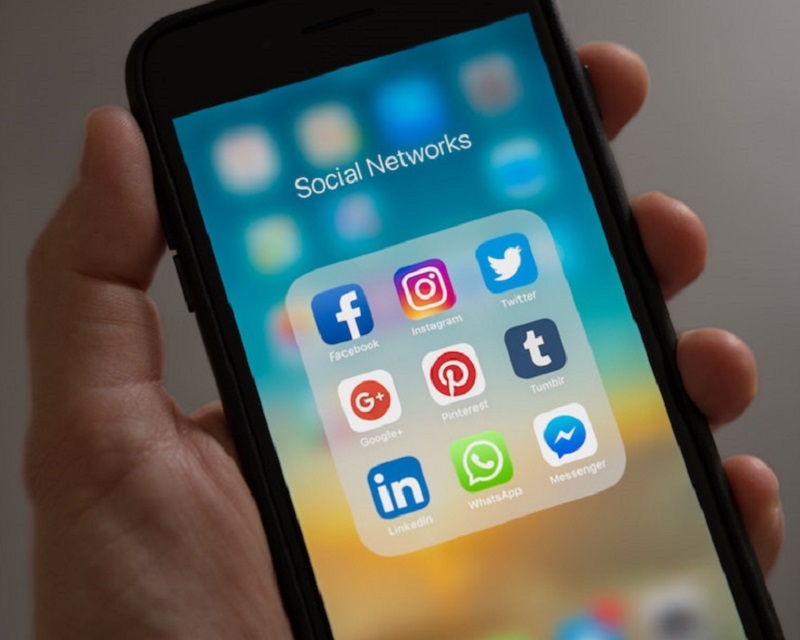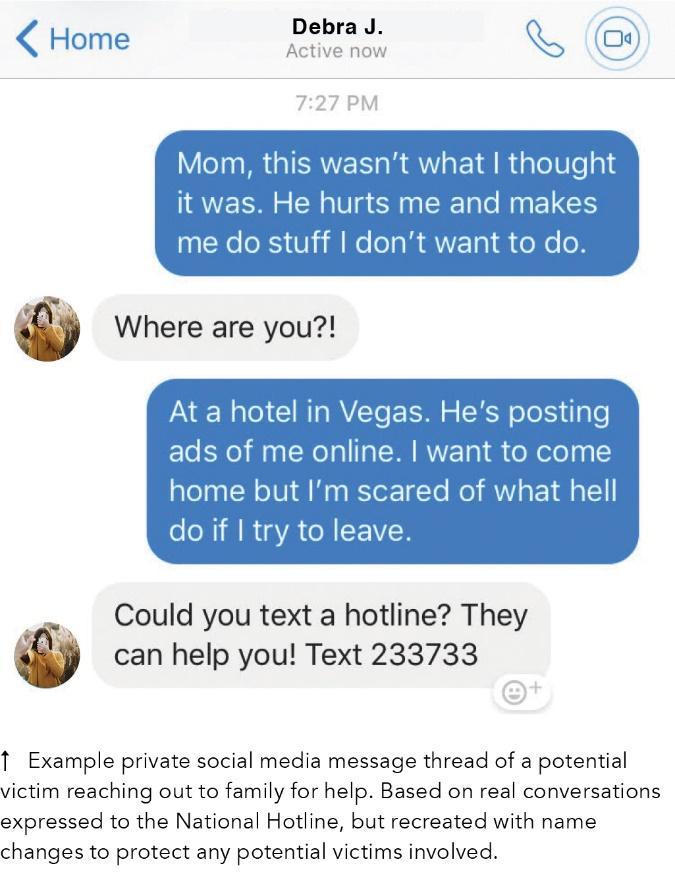
Social media is designed to build connections between individuals, and victims of trafficking are no exception. While human traffickers use online platforms to recruit, advertise, monitor, and abuse their victims, it is also important to bear in mind that many victims are actively using social media during their exploitation to seek safety, support, and even to coordinate their exits.
In fact, more than three-quarters of survivors surveyed by Polaris in 2017 reported that they used internet platforms during their exploitation and 27 percent of those stated that they were on social media “very frequently.”
Connecting with support systems
A victim may not have cell phone service to call or text friends and family, but they might be able to connect to Wi-Fi at their hotel or employer’s home to access social media for help. The National Human Trafficking Hotline has received countless calls and texts from family members who have had their trafficked loved ones reach out to them via platforms like Facebook Messenger, direct messages on Instagram, Snapchat, or through Kik. 20 percent of survivors in Polaris’s online survivor survey stated that they utilized private messages on social media apps to communicate with friends and family during their exploitation.
A person’s ability to maintain contact with friends and family is often interrupted or forbidden while in their trafficking situation, but social media platforms can provide an avenue to provide a general update without coming off as ‘suspicious’ to a trafficker that is micromanaging communications between their victim and any support network they might have. Location check-ins may provide loved ones with indicators of their whereabouts, while features such as Snapchat’s disappearing messages can provide safe communication without putting a person at risk if their trafficker accesses their phone.

Getting and staying safe
Social media and certain technologies within a social media platform can play a critical role in a victim’s safety plan, during their trafficking situation and in plans to escape or exit the situation. In Polaris’s survivor survey, 19% of survivors reported that social media played a role in their exit.
“A woman approached me one day in a hotel and gave me her contact information on a piece of paper. She told me that if I ever needed help that she would help me. At that time, I didn’t know that she was a service provider with a safe house for human trafficking victims, but several weeks later I called. Talking on the phone was not safe, instead we did a lot of private messaging over Skype and Facebook which felt safer for me (due to the fact that it was easier to hide then phone calls) and eventually months later those private message conversations lead to my first escape/exit.” – Human trafficking survivor
Disappearing messages and video
Victims and survivors of human trafficking may use disappearing messages or videos to connect to their support system without fear of their trafficker finding these messages in their devices later on. Potential victims from the National Human Trafficking Hotline have sent disappearing messages, pictures, or videos of abuse via Snapchat to loved ones, in a fast and creative way to ask for help. Multiple domestic violence shelters and crisis intervention specialists are now using disappearing messages and photos to provide information to victims who wish to escape their abuser.
In one situation, a trafficker became aware that a trafficking victim planned to escape and he decided to move her to a different location. She was able to take a photo of his license plate, vehicle, and road signs and send them through Snapchat to local service providers. This aided the police in tracking his vehicle and led them to her location.
Many survivors in Polaris focus groups expressed how even if they had the foresight to safety plan with their social media use, they sometimes didn’t have the time to delete their messages or browsing history before their trafficker found their device.
“My trafficker did not use to monitor my phone unless I was acting kind of funny. Then he’d be like, “give me your phone.” I wouldn’t have a chance to delete anything. At least with [disappearing messages], I know there’s nothing there.” – Human trafficking survivor
Location discovery services
Another feature on social media that has been used by potential victims on the National Human Trafficking Hotline is location discovery services. In some cases, a trafficker may move their victims around a lot, which can often cause isolation and confusion as to their current location. Potential victims on the Hotline have been able to use a social network’s location discovery services to figure out what city they are in or publicly “check in” to signal their location to their family and friends.
While this can be used by victims to alert others and find out their own location, the risk of all these tools is that they can also be used by traffickers to stalk and harm victims and survivors. For example, a survivor may themselves be intentional about not posting online when they return to their home town to protect themselves from their former abuser, but she forgot to tell her friends and they do a “check-in” which mentions the survivor. The survivor doesn’t even realize it until she has already received multiple calls and texts from her abuser threatening her. This makes it extremely important for all these privacy features to be available, intuitive, and easy to turn on and off!
Other safety features and concerns
Of course, victims and survivors also use safety and privacy features on social media such as blocking users, friends/follower sub-groups, tagged photo requests, disabling location services, and removing their profile from general search results.
Some other safety features can include:
- Passcode protected folders or photo albums
- Customizable audience settings for individual social media posts
- Online Safety Centers with tips, tools, and tricks to manage your personal online safety (Facebook’s Safety Center is a great example!)
- Easy to follow and accessible safety and privacy resources, like this guide created for domestic violence survivors by the National Network to End Domestic Violence and Facebook.
While there are some great examples of innovative tools social media platforms have rolled out over the years, sometimes implementing a new feature can inadvertently put potential victims and survivors of abuse in further harm. One example is the automatic tagging of locations where photos are taken. When these photos are then shared online, the location is shared as well. Traffickers can use the fact that they know where the victim is as a tool of intimidation or control.
Unfortunately, in situations like this victims and survivors often discover things like this too late – when they have already sent the photos or otherwise engaged with an app that they later learn is unsafe. Instead of requiring users to have to “opt-out” of new features, social media platforms should consider having users “opt-in” to allow each person to evaluate their individual privacy needs.
Such simple considerations and alterations to existing platforms can make all the difference in the world for a trafficking victim or survivor looking to stay safe or leave a scary or dangerous situation.
What can I do to help?
Take our pledge to actively commit to fighting human trafficking by spreading awareness on this issue and learning the warning signs of social media recruitment. You can also sign our petition for the Match Group to ask them to implement safety features to help keep human trafficking off of their platform. You can also learn more about the intersection of social media and human trafficking in our report.
This blog was written in collaboration with K.D. Roche, Human Trafficking Field Expert, Consultant, and Survivor.


